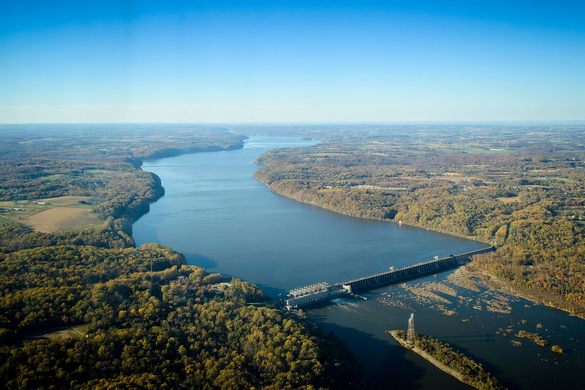With a watershed covering nearly 27,500 square miles across three states, the Susquehanna River is Chesapeake Bay’s largest tributary and contributes more than half of the bay’s fresh water. Located at the bottom of the Susquehanna River watershed, about ten miles from where the river enters the upper Chesapeake Bay, Conowingo Hydroelectric Dam was constructed in 1929 to provide power to the city of Philadelphia. The dam historically trapped sediments and nutrients flowing down the Susquehanna River watershed within its reservoir.

"Susquehanna River and Conowingo Dam" Photo Courtesy of aaronmharrington, licensed under CC BY-SA 2.0.
The reservoir behind Conowingo Dam is now full and no longer effectively trapping sediment. This infill condition has altered the timing and delivery of sediments and associated nutrients to the Bay. As a result, more nitrogen, phosphorus and sediment are now entering the Chesapeake Bay during high flow events. This additional pollutant load (estimated at 6 million pounds total nitrogen and 260,000 pounds total phosphorus annually) must be addressed to meet the Bay’s water quality standards.
In July of 2021 a multijurisdictional Conowingo Watershed Implementation Plan (CWIP) was developed by the Chesapeake Bay Program (CBP) Partnership to reduce pollution to the Bay from Conowingo infill. In July 2022, the CBP also approved a phased approach to CWIP implementation, with the first phase ending in 2025, and a reevaluation beginning in 2026.
Maryland is implementing a 3-pronged strategy to address pollution loads and ecosystem impacts from the Conowingo Dam, including:
Collaborating with PA and NY on Conowingo WIP Implementation to reduce the increased nutrient loads to the Bay from Conowingo Pond infill:
Maryland put $25-million in the FY23 State Budget for Conowingo WIP Implementation. A memorandum of understanding has been approved by Maryland and the Susquehanna River Basin Commission (SRBC) to implement a pay-for-success program with these dollars that will purchase the lowest cost nutrient reductions throughout the Susquehanna River watershed.
The settlement agreement with Constellation to reduce pollution loads, increase resiliency, and help restore ecosystems and aquatic life in the Susquehanna River Basin watershed:
The Conowingo settlement agreement requires Constellation Energy to invest more than $200 million in environmental projects and operational enhancements over the life of its current 50-year hydropower license from the Federal Energy Regulatory Commission (“FERC”) that will improve water quality in the Lower Susquehanna River and the Chesapeake Bay. The restoration actions include:
Improvements to downstream flow to restore a more natural hydrology to the river system;
Restoring lost ecosystem services such as the filtering of pollution by freshwater mussels and oysters as well as funds to implement other projects to reduce nutrient loads from the Susquehanna River;
Improving upstream american eel and fish passage to advance efforts to restore lost fisheries for American shad and river herring, species which were blocked for many decades from moving upstream to spawn.
Improving the resiliency of the River to climate change, including SAV restoration, living shoreline construction and floodplain management; and,
Managing trash and debris from the Susquehanna River watershed that accumulates behind Conowingo Dam during low flow periods and passes through during high flows, creating a nuisance for recreational boating and swimming.
Advancing Environmental Dredging within Conowingo Reservoir as a Pollution Reduction Strategy:MDE funded a $3.3-million Conowingo Sediment Characterization and Innovative Reuse and Beneficial Use pilot to provide Maryland with better information on the quality of sediments behind the dam, dredging costs, dredged material reuse options, scalability, and feasibility for addressing Conowingo’s pollution impacts. In fiscal year 2023, Maryland’s budget also included $6-million to do the preliminary engineering, design, public outreach and agency coordination needed in advance of a larger Conowingo dredging and reuse project. At the same time MDE is working through the CBP to quantify the nutrient reduction potential of a Conowingo environmental dredging program.
These financing, best management practice, and implementation innovations provide a great opportunity to modernize and accelerate Chesapeake Bay restoration. By leveraging pay-for-success financing, targeting best management practices (BMPs) in the most effective areas of the watershed, pushing development of new BMPs and science, and collaborating across jurisdictions to address pollution, Conowingo is helping to create new restoration approaches across the watershed and nation. To ensure success, MDE will continue to lead Conowingo efforts within the Bay Program Partnership and strive for continuity across administrations in funding and prioritization.